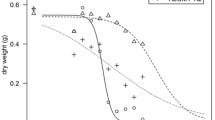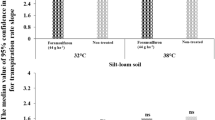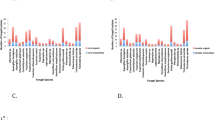Abstract
A qualitative comparison was made of the genera of fungi associated with creeping bentgrass turf (Agrostris palustris) plots either nonsprayed or sprayed with six fungicides for 4 or 5 successive years. The fungicides used were:
Fore (manganese ethylene bisdithiocarbamate plus zinc ion) Actidone-Thiram (3[2-(3, 5-dimethyl-2-oxycyclohexyl)-2-hydroxy-ethyl]) glutarimide plus tetramethyl thiuram disulfide); Dyrene (2, 4-dichloro-6-0-chloroanillino-s-triazine; Kromad plus Calaclor (5% cadmium sebacate, 5% potassium chromate, 1% malachite green, 0.5% auramine, 16c tetramethyl thiuram disulfide plus 60% mercurous chloride, 30% mercuric chloride); PMA plus Thiram (phenylmercuric acetate plus tetramethyl thiuram disulfide); and Tersan OM (hydroxymercuric chlorophenol plus tetramethyl thiuram disulfide). None of the fungicides had any significant effect on the distribution of fungal genera studied.
Similar content being viewed by others
References
Burchfield, H. P. (1960) Performance of fungicides on plants and in soilphysical, chemical, and biological considerations. pp. 447–520. In:J. G. Horsfall andA. E. Dimond (ed). Plant Pathology. Vol. III. Academic Press, New York and London.
Endo, R. M. (1961) Turfgrass diseases of southern California.Plant Dis. Rep. 45:869–873.
Garret, S. D. (1963) Soil fungi and soil fertility. Macmillan Company, New York. 165 p.
Healy, M. J. (1967) Factors affecting the pathogenicity of selected fungi isolated from putting green turf. Ph. D. Thesis, University of Illinois. 58 p.
Massie, L. B., Cole, H. &Duick, J. (1968) Pathogen variation in relation to disease severity and control ofSclerotinia dollar spot of turfgrass by fungicides.Phytopathology 58:1616–1619.
Meyer, W. A. &Sinclair, J. B. (1970)Pyrenochaeta terrestris. A root pathogen on creeping bentgrass.Plant Dis. Rep. 54:506–507.
Papivizas, G. C. &Davey, C. B. (1959) Evaluation of various media and antimicrobial agents for isolation of soil fungi.Soil Sci. 88:112–117.
Richardson, L. T. (1954) The persistence of Thiram in soil and its relationship to the microbial balance and damping-off control.Can. J. Bot. 32:335–346.
Rodriguez-Kabana, R. (1967) An improved method for assessing soil-fungus population density.Plant and Soil 26:393–396.
Steiner, G. W. &Watson, R. D. (1965) Use of surfactants in the soil dilution and plate count method.Phtopathology 55:728–730.
Tjitrosomo, W. (1966) The microfungi of forest and prairie soils in East-Central Illinois. Ph. D. Thesis, University of Illinois. 92 p.
Weihing, J. L., Shurtleff, M. C. &Partyka, R. E. (1969) Lawn diseases in the Midwest. North Central Regional Ext. Pub. No. 12. 19 p
Additional information
Department of Plant Pathology University of Illinois, Urbana, Illinois 61801.
Rights and permissions
About this article
Cite this article
Meyer, W.A., Britton, M.P., Gray, L.E. et al. Fungicide effects on fungal ecology in creeping Bentgrass turf. Mycopathologia et Mycologia Applicata 43, 309–315 (1971). https://doi.org/10.1007/BF02051750
Accepted:
Issue Date:
DOI: https://doi.org/10.1007/BF02051750




